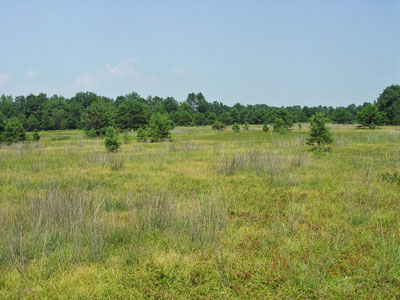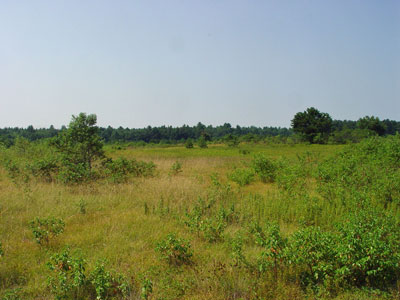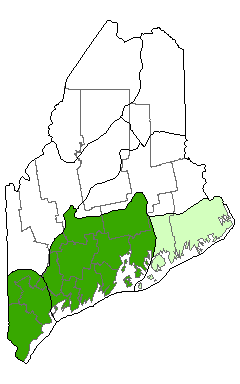DACF Home → Bureaus & Programs → Maine Natural Areas Program → Communities, Plants, and Animals → Natural Community Fact Sheets → Sandplain Grassland
Printer Friendly Fact Sheet - 650 KB pdf (Get a free copy of Adobe Acrobat Reader)
Sandplain Grassland
Scientific Name: Little Bluestem - Blueberry Sandplain Grassland; State Rank: S1

- Community Description
- Soil and Site Characteristics
- Diagnostics
- Similar Types
- Conservation, Wildlife and Management Considerations
- Distribution
- Characteristic Plants
- Associated Rare Plants
- Associated Rare Animals
- Examples on Conservation Lands You Can Visit
Community Description: These grassland barrens are expanses of graminoid and dwarf shrub vegetation dominated by poverty oatgrass, little bluestem, woodland sedge, and lowbush blueberry. Northern blazing star, a globally rare wildflower, is a dominant forb at the one viable Maine occurrence of this community. Local dominants include sweetfern and black chokeberry. Species allied with pine barrens are frequent, such as gray birch, whorled loosestrife, and wood lily. Bryoids are sparse, and up to 30% of the ground is unvegetated, usually with some graminoid or shrub litter. Back to top.
Soil and Site Characteristics: These grasslands occur on flat sandy plains or deep outwash deposits. Soils are extremely well drained and acidic. Historically, fire was important in maintaining these communities and is now being used as a management tool. Back to top.

Diagnostics: Canopy cover is less than 15%; tall shrub layer is patchy but less than 25%. Poverty oatgrass, little bluestem, and woodland sedge are the dominant graminoids, often over a layer of lowbush blueberry. Back to top.
Similar Types: Pitch Pine - Scrub Oak Barrens and Pitch Pine - Heath Barrens share many species, but have well developed shrub and/or tree layers. Hudsonia River Beaches also features little bluestem, but blueberry is scarce or absent and the riverside setting is distinctive. Back to top.
Conservation, Wildlife and Management Considerations: The one viable Maine site is in conservation ownership and is managed for the rare community, rare animals, and rare plants that occur there. Prescribed burning is a major management tool. This type appears to have been more common in southern Maine historically, but most nearby sites that might have supported this community have either been developed or have transitioned to other types due to lack of fire.
This community provides nesting habitat for several rare ground nesting grassland birds including the grasshopper sparrow, upland sandpiper, and short-eared owl. These open grasslands also provide excellent habitat for a rare snake, the northern black racer. The cobweb skipper inhabits open dry fields with bluestem grasses, which it uses as its larval host plant. Several historical butterfly and moth species that may have inhabited formerly large tracts of this community include the graceful clearwing, persius dusky wing, and frosted elfin. Back to top.
Distribution: Extreme southern Maine, extending southward along the Atlantic Coast to Cape Cod (Eastern Broadleaf Forest Province). Landscape Pattern: Large Patch. Back to top.


Characteristic Plants: These plants are frequently found in this community type. Those with an asterisk are often diagnostic of this community.
- Sapling/shrub
- Gray birch
- Pin cherry
- Pitch pine
- Sweetfern
- Thicket shadbush
- Dwarf Shrub
- Black chokeberry
- Lowbush blueberry*
- Herb
- Arrow-leaved violet
- Little bluestem*
- Few-flowered sedge*
- Northern blazing star*
- Pinweed
- Poverty oatgrass
- Sharp-pointed ricegrass
- Silverrod
- Whorled loosestrife
- Woodland sedge*
- Cobweb skipper
- Grasshopper sparrow
- Northern black racer
- Short-eared owl
- Upland sandpiper
Examples on Conservation Lands You Can Visit
| Example | County |
|---|---|
| Kennebunk Plains Preserve | York Co. |